#Cross of Iron 1977
Text
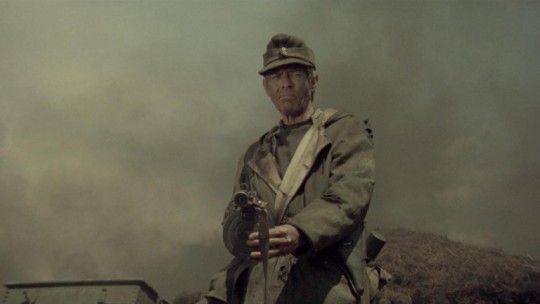


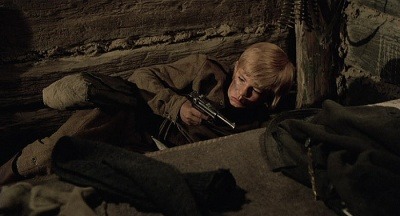




"...AND I WILL SHOW YOU WHERE THE IRON CROSSES GROW."
PIC(S) INFO: Spotlight on film stills to "Cross of Iron" (German: "Steiner – Das Eiserne Kreuz," lit. "Steiner – The Iron Cross"), the 1977 war film directed by Sam Peckinpah, featuring James Coburn, Maximilian Schell, James Mason and David Warner.
“Germany. Do you think they will ever forgive us for what we’ve done? Or forget us?”
-- Feldwebel ROLF STEINER to his squad
Cinematography: John Coquillon
Screenplay: Julius Epstein, James Hamilton, & Walter Kelley
Source: https://darrenlinder.wordpress.com/2018/08/15/sam-peckinpahs-cross-of-iron-1977.
#Cross of Iron#Cross of Iron 1977#WWII#Cinematography#Cross of Iron Movie#Super Seventies#70s Cinema#Cinema#Cross of Iron Film#German Wehrmacht#Cross of Iron 1977 Movie#WWII Movies#James Coburn#Film Stills#War Movies#Wehrmacht#Movie Stills#1977#1970s#World War II#WWII Films#World War 2#War Films#70s Movies#Anti-war#70s#Sam Peckinpah#Nazi Germany#WW2#Eastern Front
5 notes
·
View notes
Text
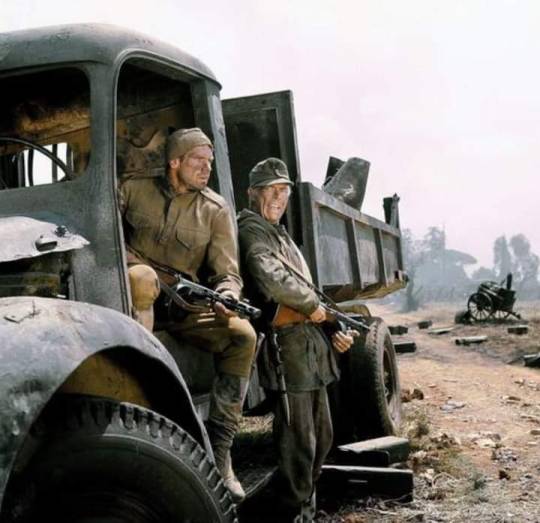
24 notes
·
View notes
Text

Cross of Iron (1977). Artwork by Robert Tanenbaum.
28 notes
·
View notes
Text

#Harley Davidson T-shirt & chain wallet? Oh you betcha. Puka shell necklace & an Iron Cross adorning my wallet chain? My bling was on#San Clemente 1977….#jakeman517#oldschool
7 notes
·
View notes
Text
Bulgarian Music in Studio Ghibli films
”Myth has it that Orpheus was born in what is now Bulgaria. It seemed to be fact, not myth, that his daughters are still singing there”
These words were written by the New York Times in the remote 1963 — the year in which the largest Bulgarian folk ensemble crossed the Iron Curtain to conquer an entire continent with its cosmic art.
The 1975 release of Le Mystère des Voix Bulgares, a compilation album of modern arrangements of Bulgarian folk songs, further popularized Bulgarian music, and in 1977, a vinyl record featuring the folk song “Izlel ye Delyo Haydutin” (Eng: Come out rebel Delyo) began its journey aboard the Voyager 1 and Voyager 2 spacecrafts.
From this point on popularity from the West spread to the East, and Bulgarian folk music made it to the entertainment industry, including legendary Japanese anime films, like the cult cyberpunk “Ghost in the Shell” or the heartwarming Studio Ghibli features.
In this short article I write about two occasions of Bulgarian music playing in Studio Ghibli’s films.
The record that inspired the creation of “Only Yesterday”
“Only Yesterday” is a 1991 Japanese animated drama film written and directed by Isao Takahata, based on the 1982 manga of the same title by Hotaru Okamoto and Yuko Tone. Set in rural Japan, the film draws parallels with the peasant lifestyle present in Eastern Europe.
The original work is a compilation of short stories about 11-year-old Taeko’s daily life in 1966. Director Takahata had a hard time making it into a movie since the manga, told in the form of a memoir, has no plot to hold a feature. Together with producer Toshio Suzuki, they came up with the solution of bringing the narrator of the story, adult Taeko, into the movie. But there is a curious anecdote about how this idea came to mind.
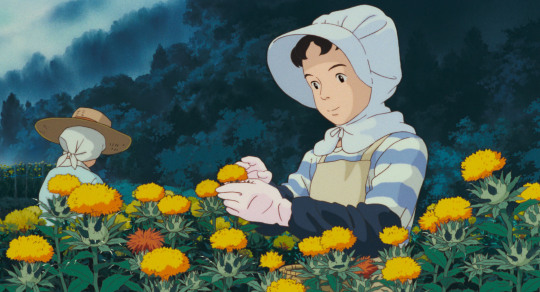
Taeko picks safflower as the Bulgarian song “Malka moma dvori mete” plays in the background. © Studio Ghibli
In a 2021 interview with students from Sofia University St. Kliment Ohridski, producer Suzuki recounts how a record of Bulgarian songs performed by the children choir “Bodra Smyana”, introduced to him by director Takahata, inspired the creation of the movie. Moved by the cosmic voices of the children, they decided to make “Only Yesterday” a musical. He also recalls what a tiring process it was to acquire the rights to the music, but if you’ve seen the movie, I am sure you will agree that it was worth it; the haunting, beautiful songs with the pastoral images of farmers picking flowers contribute to one of the greatest scenes created in cinema.
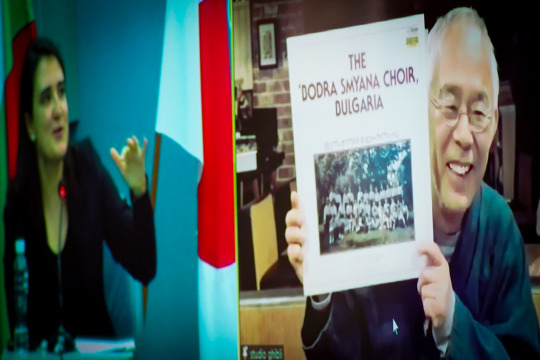
Producer Suzuki showing the record that inspired the creation of ”Only Yesterday”. Source: Studio Ghibli’s Twitter
In “Only Yesterday”, we can hear two songs from the album Bulgarian Polyphony I by Philip Koutev Ensemble. The upbeat “Dilmano Dilbero” [Eng. beautiful Dilmana] sets a happy mood as the protagonist gets changed and ready to go on the field. As the scene shifts and Taeko starts narrating a sad story about the girls in the past picking safflower with their bare hands, the song and mood shift as well.
While the first song has a fast rhythm, with lyrics about pepper planting that can also be interpreted figuratively, the second one, “Malka Moma Dvori Mete” [Eng., a little girl sweeps the yard], is a ballad about a young girl who is forced into marriage but has never known true love.
Both compositions sing about life-cycle events like marriage and the regular coming of the harvests, with lyrics perfectly fitting the setting and plot of the movie, which makes me wonder if the filmmakers chose them by chance or if they had someone translate the words.
Bulgarian Cosmic Voices Enchanting Howl
“Howl’s Moving Castle” is a 2004 Japanese animated fantasy film written and directed by Hayao Miyazaki, loosely based on the 1986 novel of the same name by British author Diana Wynne Jones. Set in a fictional kingdom the movie draws inspiration from various places in Europe. One of them being Bulgaria.
The story focuses on a young girl, named Sophie, magically transformed into an old woman, and a self-confident but emotionally unstable young wizard, Howl, living in a magical moving castle.
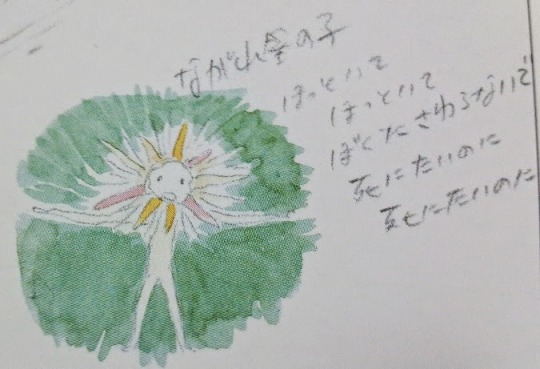
A sketch of a Star Child. Source: The Art of Howl’s Moving Castle
If you’ve seen the movie, you surely remember the scene when Madame Suliman ambushes Howl and tries to strip him of his magic powers. Star Children encircle him and his companions; their shadows grow big, dark and intimidating. They start dancing and chanting unintelligible magic words and are almost successful in their devilish act.
This scene, together with the music played in the background, have been a favourite of many fans of the film. Some even recount it giving them nightmares when they were children.
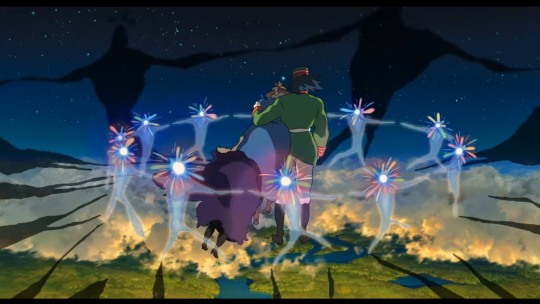
Star Children encircle Howl in an attempt to strip him of his magic powers. © Studio Ghibli
It turns out, however, that these aren’t any incantations, but the lyrics of a folk song. In Bulgarian. And a love song! Contrary to popular belief, the lyrics have nothing to do with magic and are actually about a boy taking his sweetheart, Dona, to the market to buy her new clothes. The excerpt used in the movie is very short and a bit altered from the original, but the words used go like this: Trendafilcheto, kalafercheto, Done mamino, translated as “the rose, the costmary, my darling Dona”.
I am planing a follow up article where I will post the translated lyrics together with a brief explanation on how they are related to the movies.
If you want to comment on or add something, I would love to hear!
Source
#studio ghibli#only yesterday#howls moving castle#Le Mystère des Voix Bulgares#bulgarian folklore#bulgaria#toshio suzuki#hayao miyazaki#isao takahata#bulgarian music in ghibli films#the boy and the heron#スタジオジブリ#ブルガリア#おもひでぽろぽろ#ハウルの動く城#宮崎駿#高畑勲#鈴木敏夫#bulgarian music
606 notes
·
View notes
Text

Louise Glück circa 1977
* * * *
"It is true that there is lack of beauty in the world.
It's also true I'm not the one to give it back.
There's no candor either, but I can be useful there.
I am
Working, even though I'm quiet.
The island
misery of the world
pull us closer, an alley
with rows of trees; we are
fellas here no talking,
each one with his thoughts
behind the trees, the gates
of iron houses,
the shutters closed
in rooms somehow empty, abandoned,
as if it were the duty
from the artist create
hope, but from what? from what?
The word itself
it's false, an instrument that refutes
the perception. At the cross,
The luminous decorations of the holidays.
I was young here. Mountain
on the subway with my little book
how to protect myself
from this very world:
'you are not alone'
said the poem
in the dark tunnel".
- Louise Glück | “October” Snippet
Note: Yesterday, October 13, Louise Glück, one of the great voices of American poetry, passed away at age 80. In 2020 he received the Nobel in Literature, culminating a career for which he had already received awards such as the Pulitzer Prize, the Averno or the National Book Prize in the United States, among others. If for something he stood out, it was for his direct, honest poetry, where he did not hide his pain or trauma, nor his fighting spirit. This poem, which is one of our favorites, entitled, precisely, "October", summarizes part of his life philosophy. Rest in peace.
(Translation is by Abraham Gragera and Ruth Miguel Franco for Pre-texts)
[Hermeneuta. Revista cultural]
29 notes
·
View notes
Quote
Swastikas in punk are basically another way for kids to get a rise out of their parents and maybe the press, both of whom deserve the irritation. To the extent that most of these spikedomes ever had a clue what the stuff originally meant, it only went so far as their intent to shock. "It's like a stance", as Ivan [Julian] says. "A real immature way of being dangerous."
Maybe. Except that after a while this casual, even ironic embrace of the totems of bigotry crosses over into the real poison...
Something harder to pass off entered the air in 1977, when I started encountering little zaps like this: I opened up a copy of a Florida punk fanzine called New Order and read an article by Miriam Linna of the Cramps, Nervus Rex, and now Zantees: “I love the Ramones [because] this is the celebration of everything American — everything teenaged and wonderful and white and urban…” You could say the “white” jumping out of that sentence was just like Ornette Coleman declaring This Is Our Music, except that the same issue featured a full-page shot of Miriam and one of her little friends posing proudly with their leathers and shades and a pistol in front of the headquarters of the United White People’s Party, under a sign bearing three flags: “GOD” (cross), “COUNTRY” (stars and stripes), “RACE” (swastika).
Sorry, Miriam, I can go just so far with affectations of kneejerk cretinism before I puke.
Lester Bangs, The White Noise Supremacists
#racism cw#lester bangs#nazis cw#i've said it before but all us goths and punks have to read this essay
99 notes
·
View notes
Text
CROSS OF IRON (Peckinpah, 1977)
24 notes
·
View notes
Text
NATO's Nazi Background
Literally, Hitler's Chief of Staff Adolf Heusinger became the Chairman of the Military Committee for NATO from 1961-1964
Then there's one of Hitler's most infamous German Field Martials Erwin Rommel's Chief of Staff, General Hans Speidel became the Supreme Commander of NATO's Ground Forces in Central Europe from 1957-1963.
And then again from 1971 to 1975 a notorious Luftwaffe Fighter Pilot who even earned the Knights Cross of the Iron Cross, one of Nazi Germany's highest medals of honor, named Johannes Steinhoff became Chairman of NATO's Military Committee.
As if THAT wasn't enough, Johann Von Keilmansegg, who was a General Staff Officer to the High Command of the Wermacht, occupied the position of Commander in Chief of Allied Forces Central Europe from 1967-1968.
A Major in the Wermacht and Group Leader of the Organizational Department of the Supreme Command of the Wermacht from 1943-1945 and a recipient of the Iron Cross named Ernst Ferber was NATO's Commander in Chief of Allied Forces 1973-1975
And NATO's Commander in Chief of Allied Forces Central Europe from 1977-1979 was Franz Joseph Schulze who was a Lieutenant in the reserve and Chief of the 3rd Battery of the Flak Storm Regiment 241 and became a recipient of the Knights Cross of the Iron Cross in 1944.
Another Nazi, Ferdinand von Senger und Etterlin who was a Lieutenant in the 24th Panzer Division in the German 6th Army, a participant in the Battle of Stalingrad, adjutant to Army High Command, of course became NATO's Supreme Commander of Allied Forces Central Europe from 1979 to 1983.
So to make this perfectly clear; the United States who led the creation of NATO with its Allied partners the UK and France, instead of capturing, imprisoning and prosecuting in a War Crimes Tribunal like the Nuremberg Trials this list of Nazi War Criminals, these Western Imperialist Powers chose to put these Nazis in charge of NATO and its Armed Forces.
If you think the NATO of today is any different; that it wouldn't ally itself with Nazis today, like in Ukraine, then you are sorely mistaken.
Here's a couple of links if you have any doubts
Adding this pic:

#nato#nato and nazis#nazis in nato#nato imperialism#nato news#nato facts#us imperialism#imperialism#western imperialism#capitalism#capitalist imperialism#neoliberalism#neoliberal capitalism#socialism#communism#marxism leninism#socialist politics#socialist news#socialist worker#socialist#communist#marxism#marxist leninist#progressive politics#politics#ukraine war#nazis in ukraine#ukrainian nazis#ukraine proxy war#us hegemony
28 notes
·
View notes
Text
Tatahouine: ‘Star Wars meteorite’ sheds light on the early Solar System
by Ben Rider-Stokes, Post Doctoral Researcher in Achondrite Meteorites at The Open University

Locals watched in awe as a fireball exploded and hundreds of meteorite fragments rained down on the city of Tatahouine, Tunisia, on June 27, 1931. Fittingly, the city later became a major filming location of the Star Wars movie series. The desert climate and traditional villages became a huge inspiration to the director, George Lucas, who proceeded to name the fictional home planet of Luke Skywalker and Darth Vader “Tatooine”.
The mysterious 1931 meteorite, a rare type of achondrite (a meteorite that has experienced melting) known as a diogenite, is obviously not a fragment of Skywalker’s home planet. But it was similarly named after the city of Tatahouine. Now, a recent study has gleaned important insights into the the origin of the meteorite – and the early Solar System.
Lucas filmed various scenes for Star Wars in Tatahouine. These include Episode IV – A New Hope (1977), Star Wars: Episode I – The Phantom Menace (1999) and Star Wars: Episode 2 – Attack of the Clones (2002). Various famous scenes were filmed there, including scenes of “Mos Espa” and “Mos Eisley Cantina”.
Mark Hamill, the actor who played Luke Skywalker, reminisced about filming in Tunisia and discussed it with Empire Magazine: “If you could get into your own mind, shut out the crew and look at the horizon, you really felt like you were transported to another world”.

Composition and origin
Diogenites, named after the Greek philosopher Diogenes, are igneous meteorites (rocks that have solidified from lava or magma). They formed at depth within an asteroid and cooled slowly, resulting in the formation of relatively large crystals.
Tatahouine is no exception, containing crystals as big as 5mm with black veins cutting cross the sample throughout. The black veins are called shock-induced impact melt veins, and are a result of high temperatures and pressures caused by a projectile smashing into the surface of the meteorite’s parent body.
The presence of these veins and the structure of the grains of pyroxene (minerals containing calcium, magnesium, iron, and aluminum) suggest the sample has experienced pressures of up to 25 gigapascals (GPa) of pressure. To put that into perspective, the pressure at the bottom of the Mariana Trench, the deepest part of our ocean, is only 0.1 GPa. So it is safe to say this sample has experienced a pretty hefty impact.
By evaluating the spectrum (light reflecting off their surface, broken down by wavelength) of meteorites and comparing it to asteroids and planets in our Solar System, it has been suggested that diogenites, including Tatahouine, originate from the second largest asteroid in our asteroid belt, known as 4 Vesta.
This asteroid possesses interesting and exciting information about the early Solar System. Many of the meteorites from 4 Vesta are ancient, around ~4 billion years. Therefore, they offer a window to the past events of the early Solar System that we are unable to evaluate here on Earth.
Violent past
The recent study investigated 18 diogenites, including Tatahouine, all from 4 Vesta. The authors undertook “radiometric argon-argon age dating” techniques to determine the ages of the meteorites. This is based on looking at two different isotopes (versions of elements whose nuclei have more or fewer particles called neutrons). We know that a certain argon isotope in samples increases with age at a known rate, helping scientists estimate an age of a sample by comparing the ratio between two different isotopes.
The team also evaluated deformation caused by collisions, called impact events, using a type of electron microscope technique called electron backscatter diffraction.

By combining the age dating techniques and the microscope technique, the authors managed to map the timing of impact events on 4 Vesta and the early Solar System. The study suggests that 4 Vesta experienced ongoing impact events until 3.4 billion years ago when a catastrophic one occurred.
This catastrophic event, possibly another colliding asteroid, resulted in multiple smaller rubble pile asteroids being produced known as “vestoids”. Unravelling large scale impact events such as this, reveals the hostile nature of the early Solar System.
These smaller bodies experienced further collisions that caused material to hurtle to Earth over the last 50 to 60 million years – including the fireball in Tunisia.
Ultimately, this work demonstrates the importance of investigating meteorites – impacts have played a major role in the evolution of asteroids in our Solar System.
7 notes
·
View notes
Text
316: Toto Bissainthe // Chante Haïti

Chante Haïti
Toto Bissainthe
1977, Arion
“These songs are mostly slave songs taken from the Vodou cult. They speak of the quotidian, of the suffering of exile, and the desire of Africa, not as a geographical place but as a mythical land of freedom. They express their resistance and their refusal: resistance to the colonizer, refusal of his politics, of his religion, of his culture, of his language.”
So begins Toto Bissainthe’s statement on the rear of Chante Haïti, her 1977 collaboration with a small combo of Antillean folk and French jazz musicians: vocalists Marie-Claude Benoît and Mariann Mathéus; percussionists Akonio Dolo and Mino Cinélu (Miles Davis, Weather Report, Gong); Patrice Cinélu on acoustic guitar; and Beb Guérin on the double bass. The songs indeed fuse the Vodou ritual of her native Haiti with the European avant garde sounds of her adopted milieu of Paris, where she had moved to pursue acting and found herself a de facto exile due to the political situation back home. Bissainthe had become a prominent figure in the French theatre, performing in new plays by Beckett and Genet and co-founding Les Griots, France’s first Black theatre company; by the late ‘70s, she was an acclaimed recording artist to boot. Her accomplishments made her a prominent figure in the Haitian diaspora and her activist streak is apparent throughout Chante Haïti, explicitly linking the grief and yearning for liberation in these traditional ceremonials with the country’s contemporary struggles.
Like many songs on the album, the Creole words of opener “Soley danmbalab” mourn the people's estrangement from Mother Africa, a crossing which can neither be reversed or repeated. It begins like a field recording, Bissainthe’s soulful, Miriam Makeba-esque voice set to a chorus of rattles and bells and gurgling masculine whispers. As the song develops, her melody wends like a stream through the dense jungle of percussion, dissonant bass, and counterpoint chanting. Eventually, Mino Cinélu’s arrangement becomes more free, the male chorus imploring the Oungan (a male Vodou priest) to intercede with the creator on the people’s behalf as the tune breaks down into an increasingly abstract bass and drum interplay, while the three female singers exchange birdlike vocal improvisations.
youtube
“Ibo Ogoun (Variations)” is even wilder, evoking a trance ritual, the spirits speaking in many tongues through the celebrants as they seek to summon Ogun, God of Iron and War, to lead the battle of liberation. One of the male percussionists times his tanbou beat so that it hits just as he sings certain notes, creating the illusion that he voice has suddenly lurched down an octave for a moment, almost like a DJ freaking a vocal sample. Bissainthe, Mathéus, and Benoît match the intense drumming with some crazy syncopations, sometimes talking, sometimes hissing and whispering, sometimes wailing and ululating.
Most of the album takes on a more meditative tact, anchored by Guérin’s plangent double bass. On the smoky “Papadanbalab,” an entreaty to the serpent creator Damballa to bear witness to the penury of his people, Bissainthe sways over a slinky jazz bass line, Patrice Cinélu adding mellow acoustic fusion licks. The song seems like a brief stopover in a Parisian club. But even the less overtly intense tracks pack plenty of musical interest. “Lamize pa dous” has this hypnotic rhythm that sounds exactly like a micro house beat—in fact, the first thing it made me think of was Ricardo Villalobos’ Alcachofa, or Animal Collective at their campfire ravingest. The song is about the moment of surrender to death, the winnowing of time represented by water encroaching on all sides, the realization too late that “we spend our lives trying to fill the sea with stones.”
Listening to a record like this, especially in light of Bissainthe’s note on the back excoriating the colonialist ethnographer who reduces Haitian folklore to “excitement and violence,” requires at least a smidgen of awareness from the white listener that Chante Haïti is not intended for them. The traditions it engages with are of deep spiritual significance to many Haitians, both in the ‘70s and today. But for those inside and outside the culture who are willing to approach it with respect, Chante Haïti is a fascinating fusion of Antillean and European musics, and a peek into a profound and secret history.
youtube
316/365
#toto bissainthe#haiti#haitian music#vodou#haitian vodou#vodou music#diaspora#spiritual jazz#Kréyol djaz#creole#'70s music#female singer#female musicians#protest music#music review#vinyl record
5 notes
·
View notes
Text



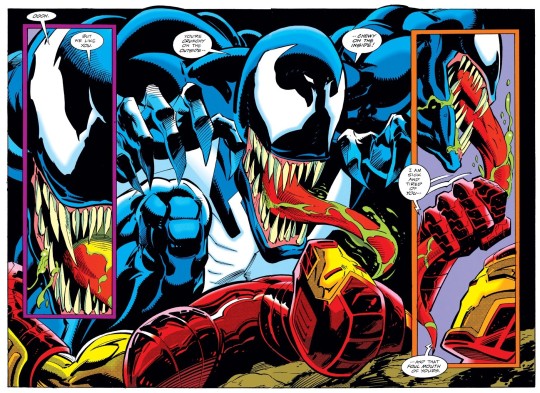




FEBRUARY FINDS -- MY ONLINE CURATED COLLECTION CONTINUES -- PART 1 OF 2.
PIC(S) INFO: Spotlight on assorted Tumblr Cover Photos for the month of February 2024, and featuring the faces and names of:
A double splash page of Wraithkind infecting planet Earth, from "ROM" Vol. 1 #49 (December, 1983)
American actor James Coburn as Steiner in the WWII-themed/anti-war film "Cross of Iron" (1977)
"Dying for Who" 7 inch by UK crust punk/D-beat band HELLKRUSHER
Venom VS. Iron Man, artwork by Kevin Hopgood, story by Len Kaminski
Whiskey photography by David Luciano
A promotional film still from the classic American apocalyptic noir "Kiss Me Deadly" (1955)
Promotional animation still from 1985 cult/dark fantasy Disney film "The Black Cauldron."
Promo photography for "First Issue" (1978), debut album by British post-punk group PUBLIC IMAGE LIMITED
Sources: www.bonappetit.com/story/history-of-my-long-drinking-life, View Comic Online, Picuki, Popmatters, Slant Magazine, Letterboxd, Reelgood, various, etc...
#Tumblr Cover Photos 2024#Cover Photos#Cover Photos 2024#Tumblr Cover Photos#Dire Wraiths#Wraithkind#Wraithworld#David Luciano#PUBLIC IMAGE LIMITED#The Black Cauldron 1985#HELLKRUSHER#D-beat#Raw punk#Discore#Anti-war#PUBLIC IMAGE#Kiss Me Deadly 1955#The Black Cauldron#Whiskey Tumbler#Gaby Rogers#Kiss Me Deadly#Whiskey#Atomic Noir#IRON MAN Vol. 1#Venom#90s Marvel#Crash & Burn#Splash page#Cross of Iron#Cross of Iron 1977
0 notes
Text
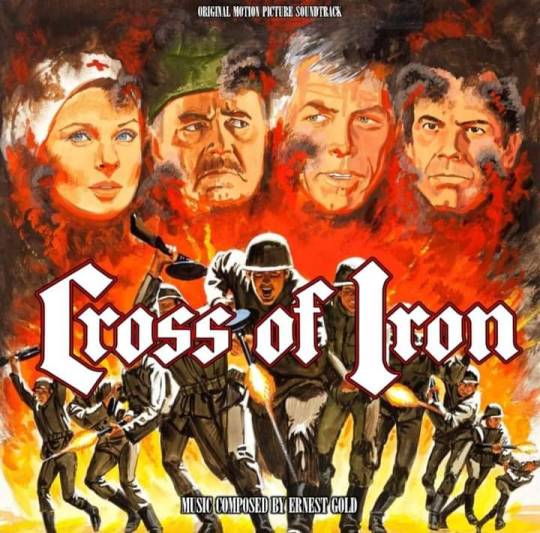
4 notes
·
View notes
Text

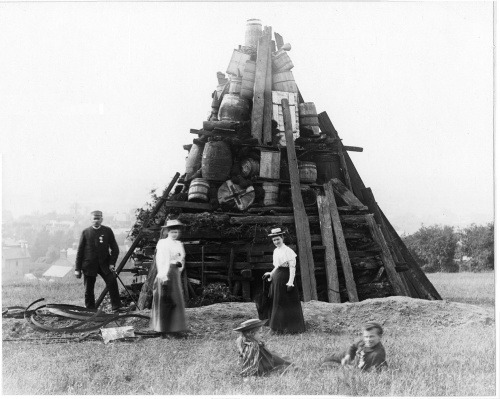
Britain has a long history of beacon lighting spanning many hundreds of years. Beacons have been lit on village greens, castle battlements, church towers, farms, beaches, front gardens, car parks and mountain tops to celebrate Royal Weddings, Jubilees and Coronations.
In 1897 beacons were lit nationally to celebrate Queen Victoria’s Diamond Jubilee. (She reigned for a total of 63 years.) In 1977 and 2002 beacons were lit to celebrate The Queen’s Silver and Golden Jubilees. On Monday 4th June 2012, the aim is to light over 2,012 - perhaps as many as 4,000 – beacons, from Tonga to the Falkland Islands and Malta to Kenya. And the network of beacons that will criss-cross the UK, placed on historic landmarks, hill-top vantage points and famous mountains, will include Ditchling Beacon.
Ditchling Beacon is an Early Iron Age contour hillfort positioned on the Downs just south of the village of Ditchling with commanding views of the Weald to the north. It is one of the 139 original anchor-chain beacons situated around the country and has been used many times for occasions of unity and celebration, but also as a communication tool to warn of impending invasion and coastal attack.
The most notable occasions were in the 16th century when raiders from France regularly struck the Sussex coast and Brighton. These attacks reached their height in June 1514 when the French, led by Admiral Prégnant (nick-named Prior John), set fire to virtually all the buildings in Brighton’s old town, with the exception of St Nicholas’ Church. They were eventually driven off by archers from across the county who were alerted by a warning beacon on the Downs. There were further raids on Brighton in 1545, but as before, the French were repelled by the large numbers who gathered on the cliff, attracted by the beacon. In 1587, Ditchling was part of the same chain of beacons, designed to provide warning of the long anticipated attack by the Spanish.
http://www.thepostmagazine.co.uk/brighto.../ditchling-beacon
9 notes
·
View notes
Text
I watched “Cross of Iron” (1977) directed by Sam Peckinpah last night. I highly recommend it to people who like historical films, and anti-war movies. Below will be some spoilers so if you don’t want those go watch the movie.
It’s set on the Eastern Front in 1943. The film starts with children singing in German while various black and white archive footage WWII plays. The protagonist is a German soldier named Steiner who is disillusioned with the war and with Germany. The central conflict is between him and his newly transferred in superior officer Stransky. Stransky is of Prussian aristocratic blood, and gave up a cushy posting in occupied Paris for the chance to win the Iron Cross. They instantly despise each other as their first interaction is Stransky ordering Steiner to execute a Soviet child soldier they took prisoner, which Steiner refuses to do. Steiner tells Stransky to do it himself if he wants to so badly, Stransky can’t bring himself to though.
Shortly after arriving, Stransky discovers that his adjutant Lt. Triebig is a gay, and in a relationship with a subordinate, and uses this as blackmail against him, threatening him and his boyfriend both with execution, telling them he will hang them together slowly. Soviets attack their position and in the chaos, Stransky cowers in his bunker, the child prisoner they took is gunned down in the crossfire, and Steiner is wounded.
Steiner wakes up in a hospital, and there is a really neat sequence where we experience his concussion through surreal editing. Steiner returns to the front and is given the rank of Sergeant. Stransky asks him to sign a document saying he witnessed Stransky lead the counterattack so that he may receive his Iron Cross. The document requires two officers to sign, and the blackmailed Triebig is the other.
When Steiner refuses to sign it he and Triebig are called before Colonel Brandt, Brandt basically confirms he knows that Stransky is a lying sack of shit, and if Steiner won’t sign the sign document he will launch an investigation would could lead to both Stransky and Triebig being punished. This causes Steiner to hesitate, and have a breakdown explaining to Brandt that he hates the war, he hates Germany, and he hates every officer even the more sympathetic ones like Brandt.
Shortly after this Soviets launch a massive offensive against the Germans, and Stransky receives the order to retreat. He orders Triebig to give the retreat order to Steiner’s platoon, but once Triebig starts to speak into the phone, Stransky cuts the phone line. Steiner and his men never receive the order and are soon engulfed in a massive Soviet attack. This sequence was spectacular, as real authentic WWII T-34 tanks were used. At one point in the battle Steiner and his men are forced to take shelter in a broken factory, which leads to an awesome scene where a T-34 drives right through the wall of the factory!
Steiner and his men are now trapped behind enemy lines. They desperately try to make it back to the German lines, at one pointing stumbling upon an unsuspecting all female Soviet brigade. Two of Steiner’s men try to take advantage of the captured Russian women and are killed. Steiner let’s the surviving women go but takes their uniforms. They use the ill-fitting uniforms to infiltrate the Soviet lines. He contacts the German command and informs them he survived and will be returning with some Russian POWs (his men in Russian uniforms). Stransky had assumed Steiner was dead, and without him to testify Brandt wouldn’t be able to prosecute him and Triebig. When Stransky learns though that Steiner survived and will be returning with a bunch of men in Soviet uniforms he suggests to Triebig that “accidents” happen in war and that he will trust Triebig to handle it.
As Steiner and his men approach the German lines disguised as surrending Soviet forces, Triebig orders a machine gunner to fire on them. The loader pleads with him not to, as they look like unarmed Soviet prisoners with their hands up being marched by a few German soldiers, but to no avail. Most of Steiner’s men are cut to ribbons. The Soviets begin bombarding the German position. Steiner reaches the German trench and Triebig tries to squirm out of responsibility, Steiner in a fit of rage guns him down. The Soviets start their massive assault at this time, and Colonel Brandt basically accepts his fate and prepares to go down in a blaze of glory.
Steiner finds Stransky, and tells him that Triebig failed. Stransky pretends to not know what he is talking about. Steiner threatens to kill him, but Stransky says that he is no coward. Steiner decides to show him “where the iron crosses grow” and hands him a gun. Stransky thinks about killing Steiner with the gun but decides against it and follows him into battle. Steiner starts to cackle like a madman as Stransky starts shooting at a Soviet child soldier before running out of ammo and desperately asking Steiner how to reload his gun. The film cuts to various black and white still images of war crimes as children sing and Steiner cackles.
It was a fantastic anti-war film. The action sequences were amazingly well shot, and the use of authentic WWII weaponry and vehicles were fantastic. Also I found the subplot about Triebig and his homosexuality interesting for a movie from 70s, yes he is an antagonist in the film but he is an unwilling one, who you see his gradual corruption at Stransky’s hands, it’s arguable that he didn’t cross any moral threshold until the end when he ordered the firing at the prisoners. Steiner even seemed sympathetic towards him to a certain point as evidenced by his reluctance to testify against Stransky when Brandt mentioned that it would also implicate Triebig.
My only real gripe with the movie is the ending, I felt it could have used more work. It just kind of ends abruptly. I read however that they had a much more spectacular ending planned but they ran out of both time and budget so they had to cobble something together last moment.
I highly recommend it. Apparently there is a sequel where Steiner returns, and this time is in France, and is plotting to kill Hitler or something, it’s by a different director and it got terrible reviews. It sounds really dumb and I probably won’t watch it, I kinda interpreted the ending of this one that Steiner accepted his fate and him and Stransky probably died off screen moments later. Having him survive and now be on the Western front seems like kinda of a cop out.
2 notes
·
View notes
Text
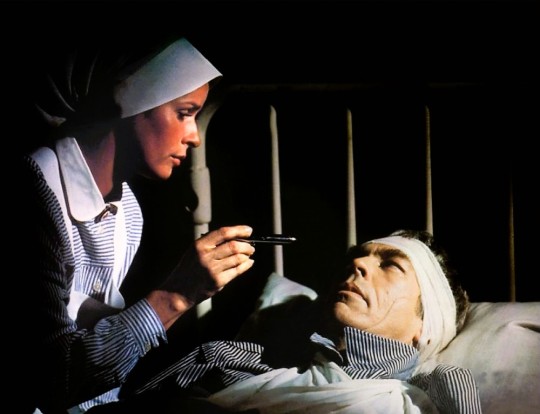
Senta Berger-James Coburn "La cruz de hierro" (Cross of iron) 1977, de Sam Peckinpah.
9 notes
·
View notes